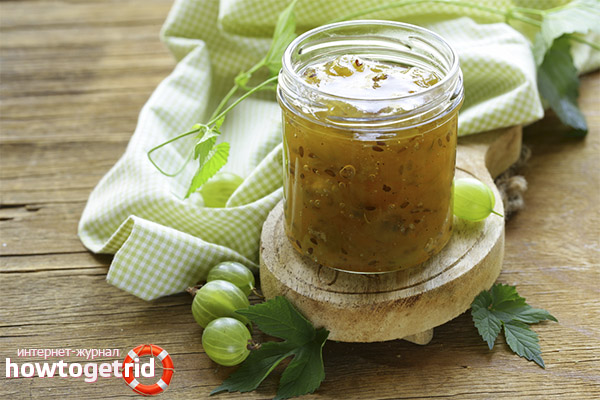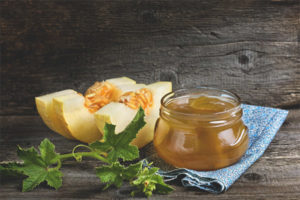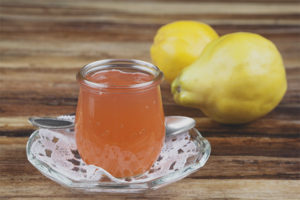The content of the article
Thorny climbing bushes can be found in almost every household plot. From mid-July, the first berries begin to appear on them. They are saturated with the sun, shine through fine peels with small grains. Gooseberries have been cultivated for a long time, but its possibilities in filling up the deficiency of vitamins, healing properties and culinary possibilities continue to be studied to this day.
Sun berry
Gooseberries belong to the genus Kamnelomkov, which indicates its ability to survive on any soil. The first mention of it dates back to the 11th century, which is recorded in the monastery chronicles. Even then, it was used in medicine and cooking. The birthplace of the bush is North Africa and Western Europe. Such a spread is explained by its quick adaptability to any climatic conditions. Seeds are carried by birds pecking ripe fruits. It was first entered into collections of useful plants in the 16th century by Jean Ruel, a bit later a more complete botanical description of the plant appeared. Through the efforts of breeders, a huge number of large-fruited varieties were bred, so in the XIX century the berry gained unprecedented popularity in all classes. Work on the development of new varieties and hybrids continues, the main directions are resistance to adverse climate and typical diseases.
Once in the forest, gooseberries quickly run wild, returning to its original form. Therefore, in the garden, it requires the tireless attention of the owner, timely pruning, feeding and watering.
The bush rarely reaches a height of 1.5 meters, usually stopping at a mark of 1 - 1.2 m. Branches are elastic, easily bent, dotted with thorns transformed from leaves. The bark is gray or brown with small exfoliating scales. Blossoms and creates an ovary in May, the fruits ripen in mid-July - August. There are early, middle and late ripening varieties. Berries can be of different shades, all contain a large amount of vitamin C, which increases immunity. The size of the fruit ranges from 12 to 40 mm. The plant is not afraid of frost, easily propagated by cuttings, quickly acclimatizes in a new place. It is often invaded by pests and can become ill without proper care. But all the troubles are paid off by the rich composition of berries and its benefits to the body.
Composition and benefits
One berry contains a wide range of nutrients, including:
- pectins;
- vitamins A, E, PP, C, K;
- niacin;
- alimentary fiber;
- potassium;
- calcium;
- sodium;
- phosphorus;
- aluminum;
- copper;
- magnesium;
- molybdenum;
- selenium;
- iodine;
- carotene;
- organic acids.
In 100 gr. The product contains 45 kcal.
Important: gooseberries are able to stimulate brain activity and prevent the development of sclerosis.
Organic acids in the composition of berries stop premature aging, improve the condition of the skin, hair, nails.An indispensable action is the rapid breakdown of fats, the elimination of harmful cholesterol, help in the work of the pancreas, and liver cleansing. For women during pregnancy and with the onset of menopause, it is strongly recommended that adequate attention be paid to gooseberries. Serotonin is a natural antidepressant, able to remove from apathy and cheer up. People with skin problems or suffering from eczema, dermatitis, psoriasis, 60 gr. a product per day will significantly alleviate the symptoms of the disease, accelerate the healing process.
Gooseberry Varieties

Unlike other berries, the content of nutrients in all species is almost the same. Regardless of the color, size and ripening period, the berries contain a shock dose of vitamin C, which increases the body's resistance to colds, infections and fungal diseases. The choice of variety is most often explained by personal preferences, climatic conditions, the desired timing of the harvest. Under favorable conditions, up to 15 kg can be collected from the middle bush. berries. The most popular varieties are:
- Ural emerald;
- Spring;
- Beryl;
- Date fruit;
- Northern captain.
Harvesting for the winter
If it was possible to save the bush from powdery mildew, drought and aphids, then he will thank with a plentiful harvest. Eat it all fresh will not work. The maximum norm for an adult per day is 1 glass. A larger amount will provoke an upset stomach and heaviness in the abdomen. Better to feast on them a little. The dense peel of berries allows you to store the crop in the refrigerator for almost a week, provided that the berries are not washed after harvesting from the branches. Slightly ripened fruits are stored for up to 3 weeks.
When the crop begins to be considered not as kilograms, but as buckets, then there is only 2 outputs:
- sell surplus in the market;
- save all the wealth for the winter in all available ways.
Gooseberries are rare species that do not lose their beneficial properties when frozen and boiled. Therefore, the berries are dried, frozen, dried, cooked candied fruits, marmalade, jam, confiture and preserves.
Dried berries
They contain enough moisture, but lend themselves to drying willingly. Medium specimens are selected for the workpiece, washed thoroughly under running water, and cleaned of stalks and sepals. After this, the berries are poured into a colander and held for several minutes over boiling water to preserve color and speed up drying.
Then they are distributed in a thin layer on a baking sheet, placed in an oven or electric dryer. You need to raise the temperature gradually, otherwise the fruits will bake. The maximum heat level is 70 degrees. After the juice has evaporated, the berries are left on a baking sheet in a cool, well-ventilated place until completely cooled. The product retains its properties for 2 years, replaces raisins in baking, is added to compotes, desserts.
Gooseberry Frozen
If you have a roomy freezer in your home, you don’t have to worry about the safety of the product. Prepared berries are placed in small portions in bags for freezing and put into storage.
Jam and Confiture
The original sweet and sour taste of berries is perfect for various culinary delights. Moreover, during heat treatment, most of the nutrients are preserved. Berries are covered with sugar at the rate of 1: 1 and left for 12 hours until the moment of juice separation. Then put on a very slow fire and cook with continuous stirring. To obtain a homogeneous mass, the cooked fruits are cooled, frayed through a sieve. The mass without seeds and peel is boiled repeatedly until the desired consistency.
Gooseberry jam

Only from this berry you can get amazing emerald jam. It is worth the labor, because it literally shines through the walls of the can, mentally returning to the blessed summer.For cooking, green varieties are selected, the name can not be recognized, suitability is determined visually. The classic recipe includes:
- gooseberry - 1 kg;
- sugar - 1 kg;
- cherry leaves - 350 gr;
- water - 600 mg.
To obtain a shining emerald color, time and proportions must be strictly observed.
- Cherry leaves are soaked in cold water for a quarter of an hour, then brought to a boil and boiled for 5 minutes.
- The washed gooseberries must be chopped with a toothpick and poured into a pan with a decoction of leaves. Scroll the dishes clockwise and leave for 10 hours. Important: do not mix the mass with a spoon.
- Squeeze the berries in a separate bowl with a slotted spoon, add sugar to the broth and boil over low heat for 3 minutes.
- Remove leaves, fill in berries, boil for 20 minutes.
- In boiling form, quickly pour into jars and tightly close.
Gooseberry and Kiwi Jam
It turns out a very unusual pleasant taste. For cooking, gooseberry, kiwi, sugar in equal proportions and 3 lemons are taken. The peel is removed from the kiwi, the fruits are cut into small pieces. Gooseberries are washed, ponytails are cut. Both ingredients are crushed in a blender, mixed with sugar, simmer for 30 minutes. Juice is squeezed out of lemons, at the end of cooking it is added to the mixture, brought again to a boil and turned off. It is displayed in sterilized jars, closed with lids. Stored in a cool dark place, perfect as a filling for sweet cakes and desserts.
If the year was fruitful and a lot of gooseberries were harvested, then the winter will be tasty. One only needs to make a little effort and cook a surprisingly fragrant and healthy jam.
Video: emerald gooseberry jam









Submit